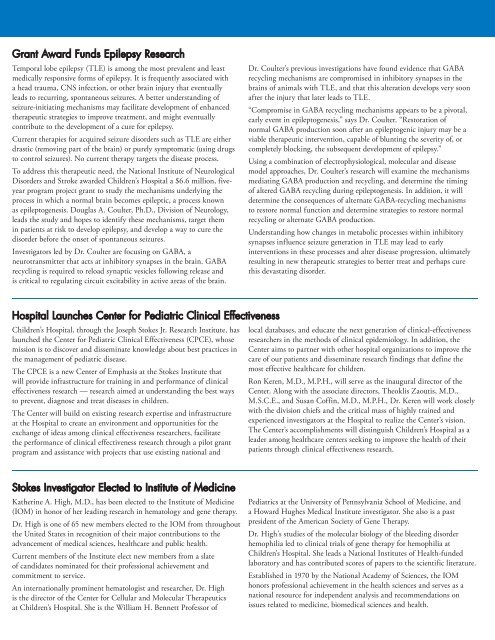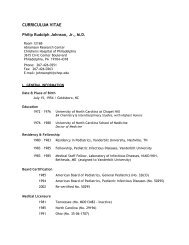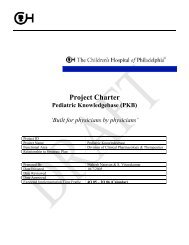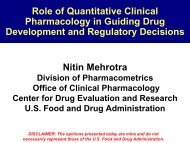to Bedside - The Children's Hospital of Philadelphia - Research ...
to Bedside - The Children's Hospital of Philadelphia - Research ...
to Bedside - The Children's Hospital of Philadelphia - Research ...
- No tags were found...
You also want an ePaper? Increase the reach of your titles
YUMPU automatically turns print PDFs into web optimized ePapers that Google loves.
Grant Award Funds Epilepsy <strong>Research</strong>Temporal lobe epilepsy (TLE) is among the most prevalent and leastmedically responsive forms <strong>of</strong> epilepsy. It is frequently associated witha head trauma, CNS infection, or other brain injury that eventuallyleads <strong>to</strong> recurring, spontaneous seizures. A better understanding <strong>of</strong>seizure-initiating mechanisms may facilitate development <strong>of</strong> enhancedtherapeutic strategies <strong>to</strong> improve treatment, and might eventuallycontribute <strong>to</strong> the development <strong>of</strong> a cure for epilepsy.Current therapies for acquired seizure disorders such as TLE are eitherdrastic (removing part <strong>of</strong> the brain) or purely symp<strong>to</strong>matic (using drugs<strong>to</strong> control seizures). No current therapy targets the disease process.To address this therapeutic need, the National Institute <strong>of</strong> NeurologicalDisorders and Stroke awarded Children’s <strong>Hospital</strong> a $6.6 million, fiveyearprogram project grant <strong>to</strong> study the mechanisms underlying theprocess in which a normal brain becomes epileptic, a process knownas epilep<strong>to</strong>genesis. Douglas A. Coulter, Ph.D., Division <strong>of</strong> Neurology,leads the study and hopes <strong>to</strong> identify these mechanisms, target themin patients at risk <strong>to</strong> develop epilepsy, and develop a way <strong>to</strong> cure thedisorder before the onset <strong>of</strong> spontaneous seizures.Investiga<strong>to</strong>rs led by Dr. Coulter are focusing on GABA, aneurotransmitter that acts at inhibi<strong>to</strong>ry synapses in the brain. GABArecycling is required <strong>to</strong> reload synaptic vesicles following release andis critical <strong>to</strong> regulating circuit excitability in active areas <strong>of</strong> the brain.Dr. Coulter’s previous investigations have found evidence that GABArecycling mechanisms are compromised in inhibi<strong>to</strong>ry synapses in thebrains <strong>of</strong> animals with TLE, and that this alteration develops very soonafter the injury that later leads <strong>to</strong> TLE.“Compromise in GABA recycling mechanisms appears <strong>to</strong> be a pivotal,early event in epilep<strong>to</strong>genesis,” says Dr. Coulter. “Res<strong>to</strong>ration <strong>of</strong>normal GABA production soon after an epilep<strong>to</strong>genic injury may be aviable therapeutic intervention, capable <strong>of</strong> blunting the severity <strong>of</strong>, orcompletely blocking, the subsequent development <strong>of</strong> epilepsy.”Using a combination <strong>of</strong> electrophysiological, molecular and diseasemodel approaches, Dr. Coulter’s research will examine the mechanismsmediating GABA production and recycling, and determine the timing<strong>of</strong> altered GABA recycling during epilep<strong>to</strong>genesis. In addition, it willdetermine the consequences <strong>of</strong> alternate GABA-recycling mechanisms<strong>to</strong> res<strong>to</strong>re normal function and determine strategies <strong>to</strong> res<strong>to</strong>re normalrecycling or alternate GABA production.Understanding how changes in metabolic processes within inhibi<strong>to</strong>rysynapses influence seizure generation in TLE may lead <strong>to</strong> earlyinterventions in these processes and alter disease progression, ultimatelyresulting in new therapeutic strategies <strong>to</strong> better treat and perhaps curethis devastating disorder.<strong>Hospital</strong> Launches Center for Pediatric Clinical EffectivenessChildren’s <strong>Hospital</strong>, through the Joseph S<strong>to</strong>kes Jr. <strong>Research</strong> Institute, haslaunched the Center for Pediatric Clinical Effectiveness (CPCE), whosemission is <strong>to</strong> discover and disseminate knowledge about best practices inthe management <strong>of</strong> pediatric disease.<strong>The</strong> CPCE is a new Center <strong>of</strong> Emphasis at the S<strong>to</strong>kes Institute thatwill provide infrastructure for training in and performance <strong>of</strong> clinicaleffectiveness research — research aimed at understanding the best ways<strong>to</strong> prevent, diagnose and treat diseases in children.<strong>The</strong> Center will build on existing research expertise and infrastructureat the <strong>Hospital</strong> <strong>to</strong> create an environment and opportunities for theexchange <strong>of</strong> ideas among clinical effectiveness researchers, facilitatethe performance <strong>of</strong> clinical effectiveness research through a pilot grantprogram and assistance with projects that use existing national andlocal databases, and educate the next generation <strong>of</strong> clinical-effectivenessresearchers in the methods <strong>of</strong> clinical epidemiology. In addition, theCenter aims <strong>to</strong> partner with other hospital organizations <strong>to</strong> improve thecare <strong>of</strong> our patients and disseminate research findings that define themost effective healthcare for children.Ron Keren, M.D., M.P.H., will serve as the inaugural direc<strong>to</strong>r <strong>of</strong> theCenter. Along with the associate direc<strong>to</strong>rs, <strong>The</strong>oklis Zaoutis, M.D.,M.S.C.E., and Susan C<strong>of</strong>fin, M.D., M.P.H., Dr. Keren will work closelywith the division chiefs and the critical mass <strong>of</strong> highly trained andexperienced investiga<strong>to</strong>rs at the <strong>Hospital</strong> <strong>to</strong> realize the Center’s vision.<strong>The</strong> Center’s accomplishments will distinguish Children’s <strong>Hospital</strong> as aleader among healthcare centers seeking <strong>to</strong> improve the health <strong>of</strong> theirpatients through clinical effectiveness research.S<strong>to</strong>kes Investiga<strong>to</strong>r Elected <strong>to</strong> Institute <strong>of</strong> MedicineKatherine A. High, M.D., has been elected <strong>to</strong> the Institute <strong>of</strong> Medicine(IOM) in honor <strong>of</strong> her leading research in hema<strong>to</strong>logy and gene therapy.Dr. High is one <strong>of</strong> 65 new members elected <strong>to</strong> the IOM from throughoutthe United States in recognition <strong>of</strong> their major contributions <strong>to</strong> theadvancement <strong>of</strong> medical sciences, healthcare and public health.Current members <strong>of</strong> the Institute elect new members from a slate<strong>of</strong> candidates nominated for their pr<strong>of</strong>essional achievement andcommitment <strong>to</strong> service.An internationally prominent hema<strong>to</strong>logist and researcher, Dr. Highis the direc<strong>to</strong>r <strong>of</strong> the Center for Cellular and Molecular <strong>The</strong>rapeuticsat <strong>Children's</strong> <strong>Hospital</strong>. She is the William H. Bennett Pr<strong>of</strong>essor <strong>of</strong>Pediatrics at the University <strong>of</strong> Pennsylvania School <strong>of</strong> Medicine, anda Howard Hughes Medical Institute investiga<strong>to</strong>r. She also is a pastpresident <strong>of</strong> the American Society <strong>of</strong> Gene <strong>The</strong>rapy.Dr. High's studies <strong>of</strong> the molecular biology <strong>of</strong> the bleeding disorderhemophilia led <strong>to</strong> clinical trials <strong>of</strong> gene therapy for hemophilia at<strong>Children's</strong> <strong>Hospital</strong>. She leads a National Institutes <strong>of</strong> Health-fundedlabora<strong>to</strong>ry and has contributed scores <strong>of</strong> papers <strong>to</strong> the scientific literature.Established in 1970 by the National Academy <strong>of</strong> Sciences, the IOMhonors pr<strong>of</strong>essional achievement in the health sciences and serves as anational resource for independent analysis and recommendations onissues related <strong>to</strong> medicine, biomedical sciences and health.






